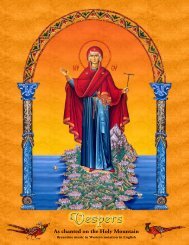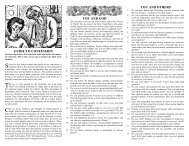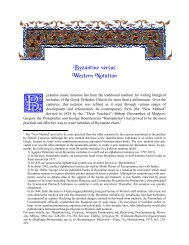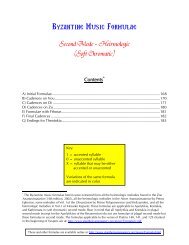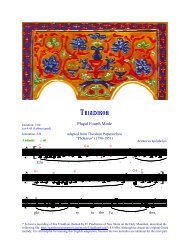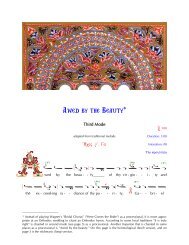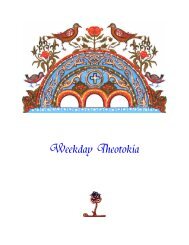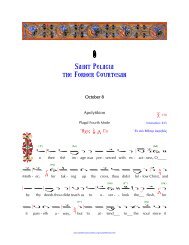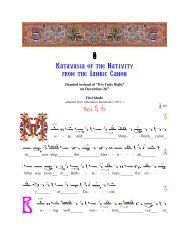Reading Psalmodia (PDF) - St. Anthony's Monastery
Reading Psalmodia (PDF) - St. Anthony's Monastery
Reading Psalmodia (PDF) - St. Anthony's Monastery
You also want an ePaper? Increase the reach of your titles
YUMPU automatically turns print PDFs into web optimized ePapers that Google loves.
the next step above and then returns. The ornament is executed not as a sequence ofdistinct notes, but as a slight disturbance of the single note. Most Psaltai place the accenton the raised part of the Flutter, but without disturbing the melodic rhythm. SomePsaltai sing a more complex ornament for the Flutter, where the voice rises very rapidlytwice or even three times to the higher pitch, falling back each time to the note of theFlutter.If the Flutter has a Roll written beneath it (f ), then the brief rising ornament occurs at theend of the first beat, and if the simple version of the Flutter ornament is sung, in manycontexts it will be sung more slowly, so that the raised part of the note lasts anything upto half a beat.The Heavy Accent accentuates the note which follows it. The note is normally at thesame pitch or one step below the note preceding the Heavy Accent. In either case, it canbe accentuated by means of an attack which begins on the step next above that on whichthe accented note is to be sung, and then descends to the step on which the note is sung,energising the note at its normal pitch with an emphatic accent. In some combinations ofsigns, some Psaltai displace the raised note of the Heavy Accent and begin the accentednote at the pitch indicated by the written sign and then introduce an ornamentationsimilar to that used in the Flutter.The Accented Diminuendo (n) accentuates the note under which it is written byadding a small melodic flourish in which the voice begins from the step of the scale nextbelow that on which the note will be sung an then moves rapidly to the note which issung with a marked emphasis. If the Accented Diminuendo is followed by a descendingsequence of notes sung to the same syllable of the text, it also affects those notes,indicating they are to be sung increasingly softly and without accentuation or emphasis.If, however, the note after the Accented Diminuendo carries a new syllable, it isaccentuated according to the rhythm of the piece and the logic of the text.The Ripple (v) is normally found written beneath the Level or <strong>St</strong>ep or beneath twosuch signs. It affects the sign under which it written, or indicates a melodic ornament atthe conjunction of the two notes indicated by the pair of signs it affects. Psaltai interpretthe Ripple in many different ways. It is clear, however, the Ripple indicates a short,rather emphatic figure which is added at approximately the midpoint of a single note, orat the pint of conjunction of a pair of notes. Usually it is sung as a glottal shake or turn,or as a figure rising suddenly to a pitch two or even three steps above the note it affectsand returning with a rapid and rather jagged movement (i.e. without any portamento.)The "throatiness" of the Ripple is an essential part of its character.The Shake (x) is found both under signs for ascent and for descent, but in both cases isnormally followed by a sign for descending motion by a single step. The Shake calls fora melodic flourish to the latter part of the note under which it lies, and for the singer tosing the note bearing the Shake and the note following as a combined figure, with noattack on the second note.




